
Electronic english version since 2022 |
The newspaper was founded in November 1957
| |
|
Number 1 (4749) |
JINR Museum
Accessible and interesting about science - for children
"CLASSroom laboratory" is the name of the experimentarium that has been successfully functioning for several years in the Museum of History of Science and Technology of JINR. First of all, these are scientific and educational excursions: both for families and for school groups. In addition, the Club of Future Scientists - a community of inquisitive children from 6 to 14 years old, as well as of their parents, has been founded at the laboratory. As part of the Club's activities, various events are regularly held, the main ones of which are "CLASSroom lessons in the museum" and intellectual games. Director of the museum Anastasia ZLOTNIKOVA shared details about it with the readers of the newspaper.
CLASSroom lessons are held for small groups of children, so that absolutely everyone can see the exhibits and participate in the experiments. The goal is to introduce children to the basics of natural sciences, to learn and understand the world around us. We try to present information simply and clearly and most importantly, in an entertaining way, while keeping the scientific basis. These are lessons where you can "touch" science, experiment and not be afraid to ask questions. Classes have been developed and are held in various sections of physics (optics, acoustics, mechanics, others), topics from biology, chemistry, mathematics, astronomy are touched upon. The story and demonstration of experiments are carried out from simple devices to more complex ones, from ordinary situations to unusual ones.
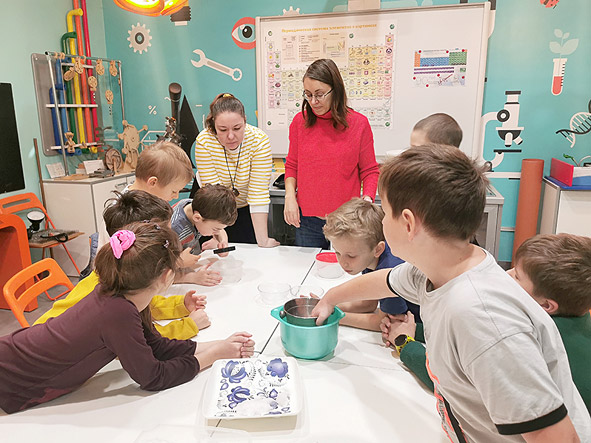
During optics classes, children eagerly sought answers to questions such as: is it possible to straighten a broken pencil; is it possible to turn an arrow on a tablet without touching the tablet itself; is it possible to pierce a 10-ruble coin with a finger. Or they tried to understand how cartoons are created, what came first - animation or cinema...
During acoustics classes, children learnt about a speaking tube and a singing coat rack, learnt what a laser vibroscope is and how a music box is made. They listened to the viscous creaking of a Chladni rod, a thunderclap and a song extracted from a vinyl record by a gramophone needle.
The "lessons" on the mechanics sections presented various types and systems of pendulums, including Newton's cradle, Chebotaev's wave pendulum and quite unexpectedly, the "walking bull" toy. The children also learnt about the mechanical toys invented many years ago. Their visual appeal is based on the witty application of immutable physical laws... During the lessons dedicated to bridges, the children were able to see and touch original prototypes of beam bridges, bridges on piers, swing bridges and drawbridges.
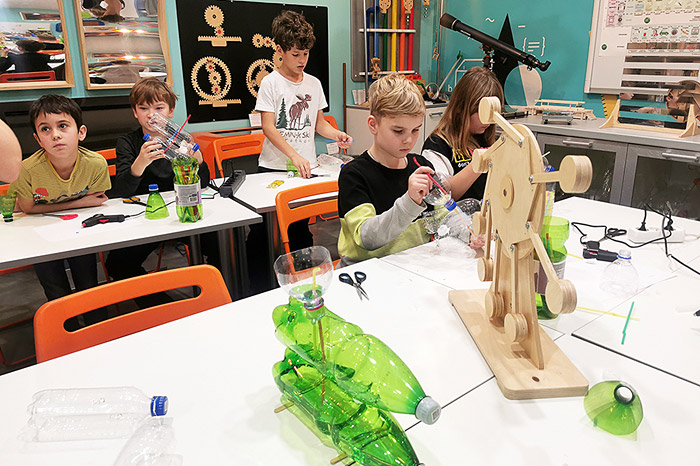
Introduction to magnetic attraction and repulsion, shooting from a magnetic gun (it was aimed shooting), the whistle of magnetic bullets and abstract paintings drawn with magnetic fluid - all this and much more was studied during lessons dedicated to magnetism.
The lessons on the topic "Secrets of paper" were very informative. Focus was on paper production technologies, different types of paper were shown, including stamped, coated, others. An ultraviolet flashlight helped the children to see hidden inscriptions and strokes on paper money. And also, unexpected mechanical capabilities of paper were demonstrated, its "soft power" that can withstand both bronze and granite.
The children were very interested in the lesson dedicated to such a science that seems to be forgotten today, as philately. They enthusiastically examined the collection that numbered over 3000 stamps, the oldest of which were printed in the middle of the 19th century in Prussia, Russia, Saxony. It is great that many children brought to the museum their personal (family) collections of stamps, postcards and talked about them with undisguised pride.
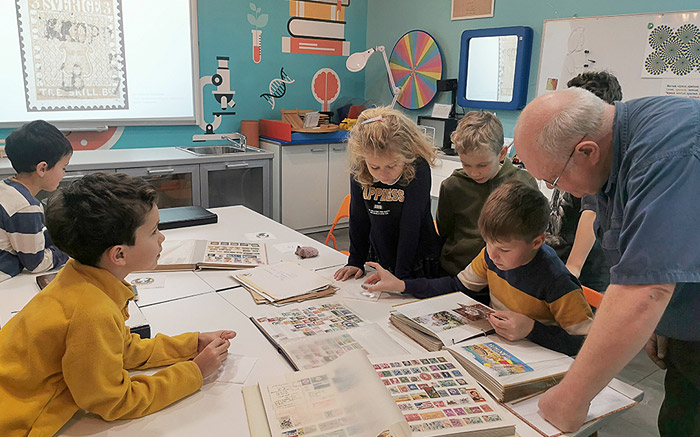
The Future Scientists' Club activities satisfy and develop children's curiosity, broaden their horizons and widely involve participants in the cognitive process. The same goals are served by the children's intellectual games held in our museum in the format of "What? Where? When?", brain rings and scientific quizzes. Sometimes, they are thematic, dedicated, for example, to ecology, great inventions, the periodic table, or means of communication. Incidentally, not only children, but also parents participate in the games. Moreover, both are equally charged with sports excitement. Intellectual games not only help to expand and enhance our knowledge, but also to develop team spirit that is necessary not only in the game.
It is gratifying that volunteers join us. Thus, students of the Department of Ecology and Earth Sciences of Dubna University held an educational meeting with the amazing world of minerals of the Moscow Region and told us about the minerals hidden under our feet. The children were able to feel like real geologists and to literally touch the collections of rocks collected by students and museum staff. There were shales, limestones, gypsums, agates, granites of local origin, as well as samples of ancient underwater fauna: scallops, belemnites, ammonites.
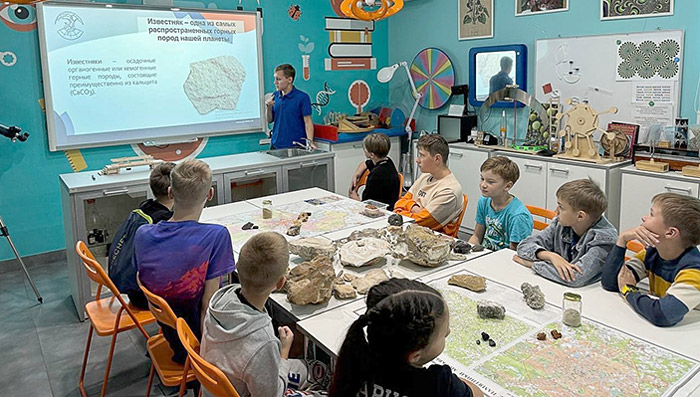
Intellectual games are sometimes held by young people that grew up before our eyes and learnt about science within our walls and for several years, have been active members of the Future Scientists' Club. They came to us to immerse themselves in the world of science at the age of 10 and today, they are students of the best technical universities. Thus, the mathematical quiz was held by the multiple winner and prize-winner of high-level Olympiads in mathematics and computer science, at present, a student of MIPT Taisiya Zlotnikova. And the New Year's astronomical brain-ring "Secrets of the Universe" was excellently prepared and presented by the Gomzin brothers. The eldest of them, Dmitry is a 10th-grade student, winner and prize-winner of the most serious Olympiads in physics and astronomy.
We are joined by parents of children that experiment at home and are ready to share their knowledge. These are both JINR employees and representatives of other science-intensive enterprises, with an education in chemistry and physics, or simply enthusiastic, creative people. Thus, at a lesson on the Alexandrian Heron Fountain, the children were able to try themselves in the role of real engineers, making prototypes of this ancient device from today's materials at hand. And they successfully coped with the unusual task.
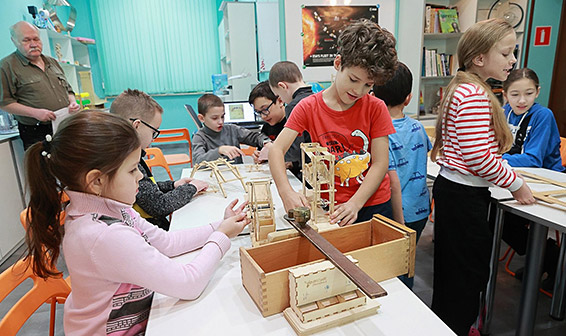
This year, we are going to make a series of classes for the youngest future scientists, for children aged 5-6. They are certainly not short of curiosity!
We will be glad to see enthusiastic people that are ready to contribute their energy, time, knowledge and skills to our Club.
If you are interested in science (physics, chemistry, biology, ecology, astronomy, geology, mathematics, engineering) and you even study it; if you love children and are ready to introduce them to the world of science, make it more understandable and interesting and if you have some free time to periodically participate in thinking of and holding classes and popular science events for children... Then you are on the right track in the direction of our museum (6 Flerova Street). You can write to us by email (zlotnikova@jinr.ru) or in the VK group https://vk.com/future_scientists, or call 216-58-31.
Let's make science understandable and interesting for our children together!